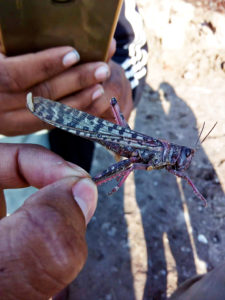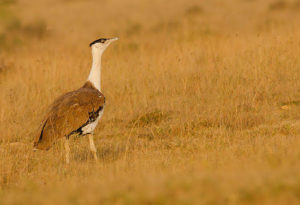Swarms of locusts invading northern parts of India may be a nuisance for locals but they are also being seen as an opportunity for biodiversity to flourish
Amid all the bad news, some good news. While locust attacks are disastrous for farmers, their presence has proved to be an opportunity for local biodiversity as they are the great source of nutrition for some species.
Sumit Dookia, wildlife biologist and assistant professor at New Delhi’s Guru Gobind Singh Indraprastha University says “Locust is a part of desert biodiversity, and food source for almost every insectivorous and carnivorous animal and bird. A wide range and size of animals eat them voraciously including the Great Indian bustard (GIB), Indian roller, bulbul, house sparrow, crow, drongo, monitor lizards, foxes and desert cats.
Interestingly, locusts have helped in conservation of IUCN classified critically endangered GIB, which is on the brink of extinction. Sumit Dookia who is also an honorary scientific advisor for a Jaisalmer based non-profit working for conservation of GIB said, “Last year we found around 15 eggs of GIB”. Which is more than usual. The possible reason for that is the rich protein source: locusts.
For this reason, green activists are opposing the use of insecticide to ward off locusts. They say that it destroys the local biodiversity as chemical compounds accumulate in the food chain when insectivorous eat them. This in the long term takes a huge toll on the environment as it endangers the lives of many species that depend on them. “There is no control and remedy to remove dead locusts after insecticides are sprayed and when an animal eats them — lethal chemicals accumulate in their body. This phenomenon is called bio- accumulation,” says Dookia.
Last year too, conservationists cited the threat to GIB due to use of insecticides to kill locusts.
Scientists believe that such a pest attack brings about a surge in the numbers of other species. “Whenever there is a pest invasion like the current locust invasion, it is associated with an increase in the population of species. This has also been seen with cricket upsurges and increases in fox populations earlier,” says YV Jhala, dean of Wildlife Institute of India and head of the GIB conservation project while talking to Down to Earth magazine.

Dr. Sachin Suroshe, the principal scientist division of entomology, ICAR-ICARI, PUSA campus, contests this claim that locust invasion affects the local biodiversity. He says that since locusts attack once in a while it can not bring any significant change in biodiversity. “Locust attack is happening due to spring rains in Africa and cyclones in the Red Sea and Arab sea and later breeding in Pakistan-Indian deserts. Since the population of its efficient predators of its eggs like Indian myna are decreasing, locusts are increasing in number and forming swarms. Locust breeding area is desert, their eggs won’t survive on black soils.” he says. “To bring any significant change in biodiversity — it must stay for a significant period of time which it doesn’t.”
Locust infestation affected crops in 2.8 lakh hectares across 13 countries before arriving in India. This year the damage is estimated to be worse than previous such infestations. Sumit Dookia gives a reason for this, “In the last few decades the field size used for agriculture has increased and the other favorable meteorological conditions were in place for locusts to attack and cause more damage than before.”

Locust swarms have wreaked havoc in the country. Amidst concerns of the pandemic, comes locust exacerbating the present challenges — like crop failure and heat waves. While locusts are traveling throughout the country eating whatever they can on their way, they have also started breeding.
As per latest reports, swarms of locusts are breeding in parts of Haryana and western Rajasthan. The centre’s locust warning organisation has warned Haryana of more such attacks. FAO in its latest brief said that “spring breed locust is shifting to summer bred areas” therefore locusts are coming back to rajasthan. The FAO expects that swarms from the horn of Africa would also join this locust and breed.
Locust are voracious consumers and impact native species relying on cropland and grasslands. There however, is no study proving the impact of locust invasion on local flora and fauna. But some anecdotal evidence says that it threatens grazing species and insects eating grass and crop. For instance, Grevy’s zebra, an endangered species from Kenya, is facing habitat loss due to swarms of locusts.
(Cover: Swarms of locusts have been invading croplands and grasslands in parts of norther India // Photo: Facebook)





